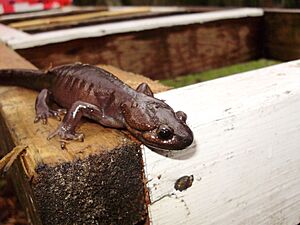Northwestern salamander facts for kids
Quick facts for kids Northwestern salamander |
|
|---|---|
 |
|
| Conservation status | |
| Scientific classification |
The northwestern salamander (Ambystoma gracile) is a type of mole salamander. It lives along the Pacific coast of North America. These salamanders can grow quite large, up to 8.7 inches (220 mm) long. You can find them from southeastern Alaska down through Washington and Oregon. Their home extends south to the Gualala River in California. They live from sea level up to the tree line, but not east of the Cascade Range. They also live on Vancouver Island in British Columbia and several islands in Washington.
Contents
What They Look Like
Eggs and Young Salamanders
Northwestern salamanders lay their eggs in a firm, jelly-like mass. It might feel a bit like a brain! Each egg is about 2 mm wide. The whole egg mass is usually the size of your fist. These egg masses are laid in water, typically about 0.5 to 2 meters below the surface.
When the eggs hatch, the baby salamanders are called hatchlings. They are tiny, only 1 to 35 mm long. They have feathery gills on the sides of their bodies to help them breathe underwater. As they grow, they become juveniles. Juveniles measure 16 to 105 mm from their snout to their vent (a small opening near the tail).
Adult Salamanders
Adult northwestern salamanders are 40 to 107 mm long from their snout to their vent. They have smooth, moist skin. Their color can vary, but they are often dark brown or black. Some adults have light spots, especially those living in the northern parts of their range.
Where They Live and What They Eat
Habitat and Location
You can find northwestern salamanders in many places. They live in moist areas, from grassy fields to dense forests. Most adult salamanders live underground. They usually come to the surface only when it rains in the fall. They also appear in spring when they move to water to breed. Sometimes, you can find them hiding under logs or other things on the ground.
Some northwestern salamanders keep their gills and stay in the water their whole lives. This is called neoteny. It means they keep some features of their young stage even as adults. This is more common for salamanders living in high-altitude areas. For example, some populations at Crater Lake in Oregon stay in the water.
What They Eat
Adult salamanders that live on land eat small creatures. Their diet includes insects, worms, and spiders. Young salamanders and those living in water eat aquatic invertebrates. This includes snails, small worms, and even tadpoles.
Protecting Northwestern Salamanders
Conservation Status
We don't know exactly how many northwestern salamanders there are. In Canada, their numbers seem to be stable. However, in the Cascade Mountains of Washington, there are fewer salamanders in young forests. They are more common in older forests.
Threats and Solutions
Cutting down all the trees in an area, called clear-cutting, makes the habitat unsuitable for these salamanders. No salamanders have been found in recently clear-cut areas. To help protect them, it's important to leave a forest buffer. This means keeping a strip of trees about 200–250 meters wide around their breeding sites. This helps keep the environment healthy for them.




